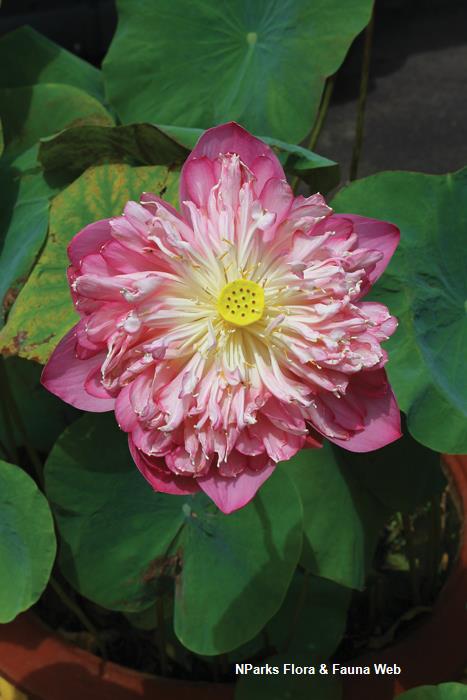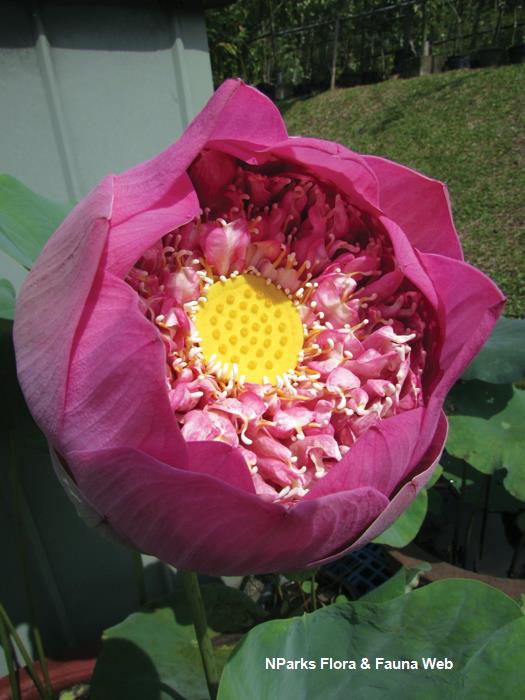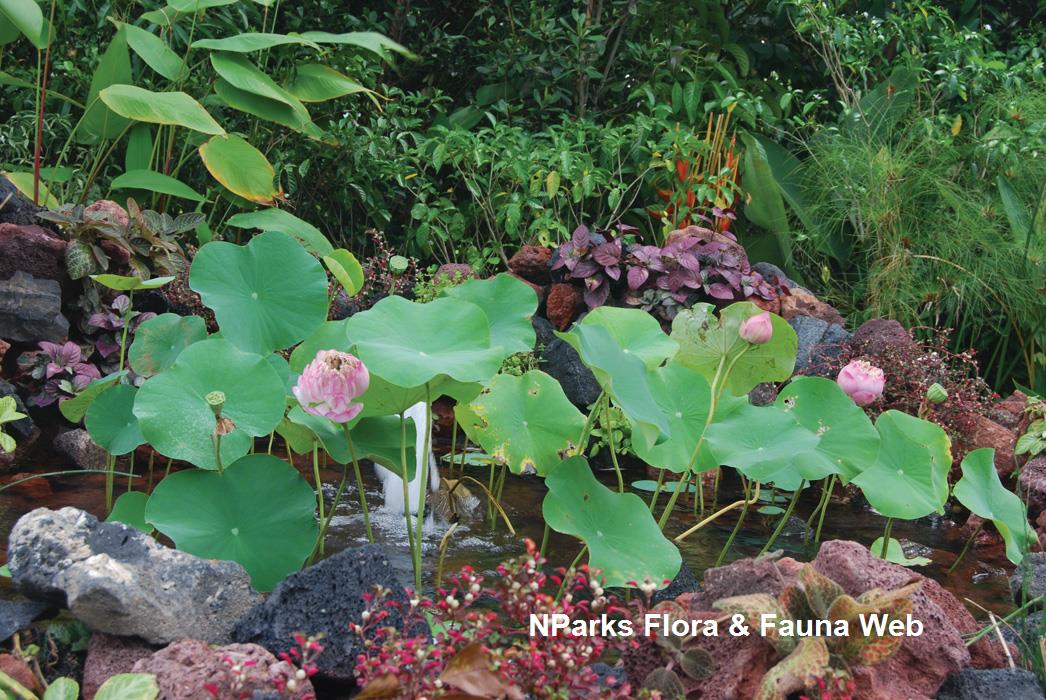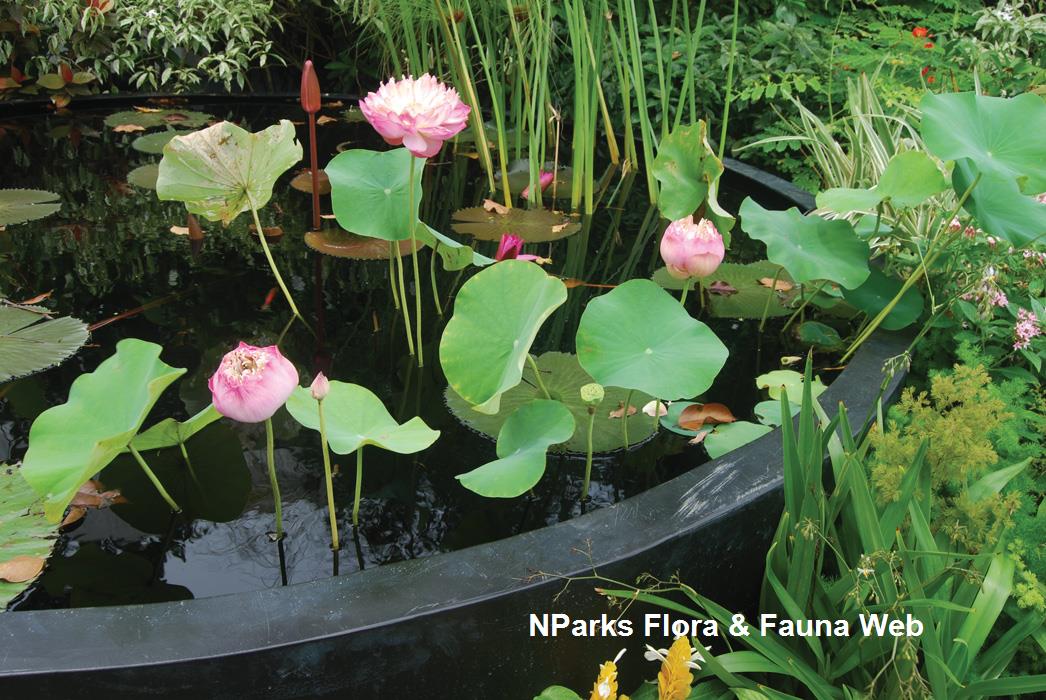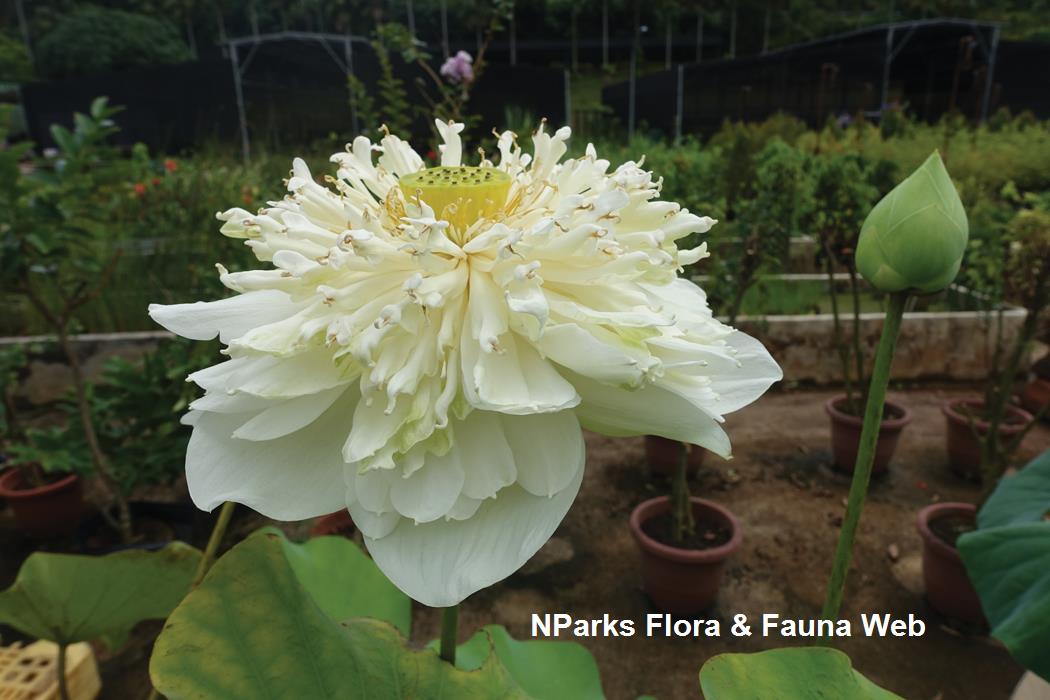
Back
Nelumbo nucifera cultivars
| Family Name: | Nelumbonaceae |
| Common Name: | Lotus, Sacred Lotus |
Lotus cultivars are emergent aquatic plants up to 2 m tall. There are 3 main types of cultivars grown for their ornamental flowers, fruit (commonly known as lotus seeds) or rhizomes (often called lotus roots). Most parts of the plant are edible.
Name
Classifications and Characteristics
| Plant Division | Angiosperms (Flowering Seed Plants) |
|---|---|
| Plant Growth Form | Aquatic & Hydrophyte (Emergent Aquatic) |
| Lifespan (in Singapore) | Perennial |
| Mode of Nutrition | Autotrophic |
| Maximum Height | 1.2 m to 2 m |
Biogeography
| Native Habitat | Aquatic |
|---|---|
| Preferred Climate Zone | Temperate, Tropical |
| Local Conservation Status |
| CITES Protection | False |
Description and Ethnobotany
| Growth Form | Aquatic perennial with emergent leaf stalks up to 2 m tall. |
|---|---|
| Roots | Although the rhizome is commonly referred to as the lotus root, it is actually an underground horizontal stem. True roots and new shoots are produced by the rhizome. |
| Foliage | The centre of the round, leaf blade is attached to a leaf stalk up to 2 m tall. Leaves repel water because of microscopic structures on the leaf surface. As the water droplets fall off, they collect dirt which helps to cleanse the leaf. |
| Flowers | Large, showy flowers up to 30 cm wide are borne singly on stalks up to 2 m tall. The flowers last for about 3 days, closing at night and re-opening the following morning. |
| Fruit | The fruit is a multiple fruit composed of several nutlets which are commonly known as lotus seeds. They are embedded in an inverted cone-shaped receptacle (5-8 cm wide) which is called a seed cup and located at the centre of the flower. |
| Similar | Although Lotus and Water Lilies (genus Nymphaea) look similar, they are not closely related plants. Lotus leaves are round like those of Water Lilies, but a Water Lily leaf has a single, deep notch which Lotus leaves do not have. Water Lily leaves also float on the water surface, while Lotus leaves are emergent, standing erect with the leaf blade held well above the water surface. Water Lily flowers either float (temperate lilies) or rise up to 15-20 cm above the water (tropical lilies), while Lotus flowers may be 2 m above the water. |
| Cultivation | Lotus cultivars grow best in full sun, but tolerate slight shade. They are best grown by planting the rhizome under 3 cm of soil that lies under still water 0.6 - 1.4 m deep. Although they also grow by collecting and sowing seed, the next generation could be different from the original cultivar type. Lotus is a heavy feeder that should be fertilised monthly. It can be propagated by dividing the rhizome which should be done every 3 years to maintain plant vigour. Lotus is generally pest- and disease-free, but occasionally aphids, mites and blight can cause problems. The leaves are sensitive to chemicals, so cultural control methods should be tried first. |
| Etymology | The genus Nelumbo is derived from the plant's name in Sri Lanka, while the specific epithet nucifera means nut-bearing. |
| Ethnobotanical Uses | Edible Plant Parts : Edible Stems, Edible Fruits, Edible Leaves Food (Fruit or Vegetable): The rhizome is prepared in a variety of ways including frying, stuffing, pickling and boiling. The rhizome is especially popular as a banquet food. In India, flowers and leaves including their young, tender stalks are eaten as a vegetable. (Herb or Spice): In Korea, different types of herbal tea are prepared from the seed cup, fruit, rhizome and flower. Medicinal: In traditional Asian folk medicine, lotus flowers are used to stop bleeding, while lotus seeds are used to treat digestive ailments like diarrhoea. However, there is currently a lack of strong clinical evidence to support these uses. Cultural / Religious: The lotus symbolises purity in Buddhism and divinity in Hinduism. In Thailand, Buddhists make offerings of lotus flowers at temples. Chinese people see the Lotus as a symbol of longevity, because its seeds can remain viable for more than 1000 years. Others: In Asian cuisine, the dried lotus leaves are used as a food wrapper for steaming rice, vegetables and meat. |
Landscaping Features
| Desirable Plant Features | Ornamental Flowers |
|---|---|
| Landscape Uses | Pond / Lake / River |
| Thematic Landscaping | Water Garden |
Plant Care and Propagation
| Light Preference | Full Sun, Semi-Shade |
|---|---|
| Water Preference | Lots of Water |
Foliar
| Mature Foliage Colour(s) | Green |
|---|---|
| Mature Foliage Texture(s) | Smooth |
| Prominent Young Flush Colour(s) | Green |
| Foliar Type | Simple / Unifoliate |
| Foliar Attachment to Stem | Petiolate |
| Foliar Shape(s) | |
| Foliar Venation | Dichotomous |
| Foliar Margin | Entire - Wavy / Undulate |
| Foliar Apex - Tip | Rounded |
| Foliar Base | Rounded / Obtuse |
Floral (Angiosperm)
| Flower Colour(s) | Pink, White, Red |
|---|---|
| Flower Texture(s) | Wrinkled |
| Flower Grouping | Solitary |
Image Repository
Others
| Master ID | 34055 |
|---|---|
| Species ID | 8471 |
| Flora Disclaimer | The information in this website has been compiled from reliable sources, such as reference works on medicinal plants. It is not a substitute for medical advice or treatment and NParks does not purport to provide any medical advice. Readers should always consult his/her physician before using or consuming a plant for medicinal purposes. |

